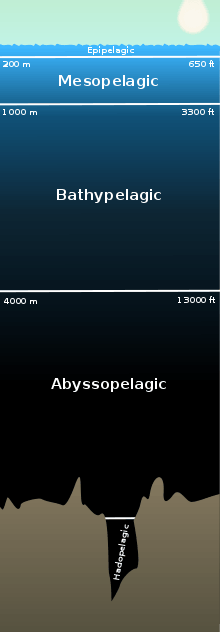Photic zone
| Aquatic layers |
|---|
| Stratification |
| See also |

The photic zone, euphotic zone (Greek for "well lit": εὖ "well" + φῶς "light"), or sunlight (or sunlit) zone is the uppermost layer of water in a lake or ocean that is exposed to intense sunlight. It corresponds roughly to the layer above the compensation point, i.e. depth where the rate of carbon dioxide uptake, or equivalently, the rate of photosynthetic oxygen production, is equal to the rate of carbon dioxide production, equivalent to the rate of respiratory oxygen consumption, i.e. the depth where net carbon dioxide assimilation is zero.
It extends from the surface down to a depth where light intensity falls to one percent of that at the surface, called the euphotic depth. Accordingly, its thickness depends on the extent of light attenuation in the water column. Typical euphotic depths vary from only a few centimetres in highly turbid eutrophic lakes, to around 200 meters in the open ocean. It also varies with seasonal changes in turbidity.
Since the photic zone is where almost all of the photosynthesis occurs, the depth of the photic zone is generally proportional to the level of primary production that occurs in that area of the ocean. About 90% of all marine life lives in the photic zone. A small amount of primary production is generated deep in the abyssal zone around the hydrothermal vents which exist along some mid-oceanic ridges.
The zone which extends from the base of the euphotic zone to about 200 metres is sometimes called the disphotic zone.[1] While there is some light, it is insufficient for photosynthesis, or at least insufficient for photosynthesis at a rate greater than respiration. The euphotic zone together with the disphotic zone coincides with the epipelagic zone. The bottommost zone, below the euphotic zone, is called the aphotic zone. Most deep ocean waters belong to this zone.
The transparency of the water, which determines the depth of the photic zone, is measured simply with a Secchi disk. It may also be measured with a photometer lowered into the water.
See also
References
- ↑ Photic zone Encyclopædia Britannica Online. 14 August 2009.



